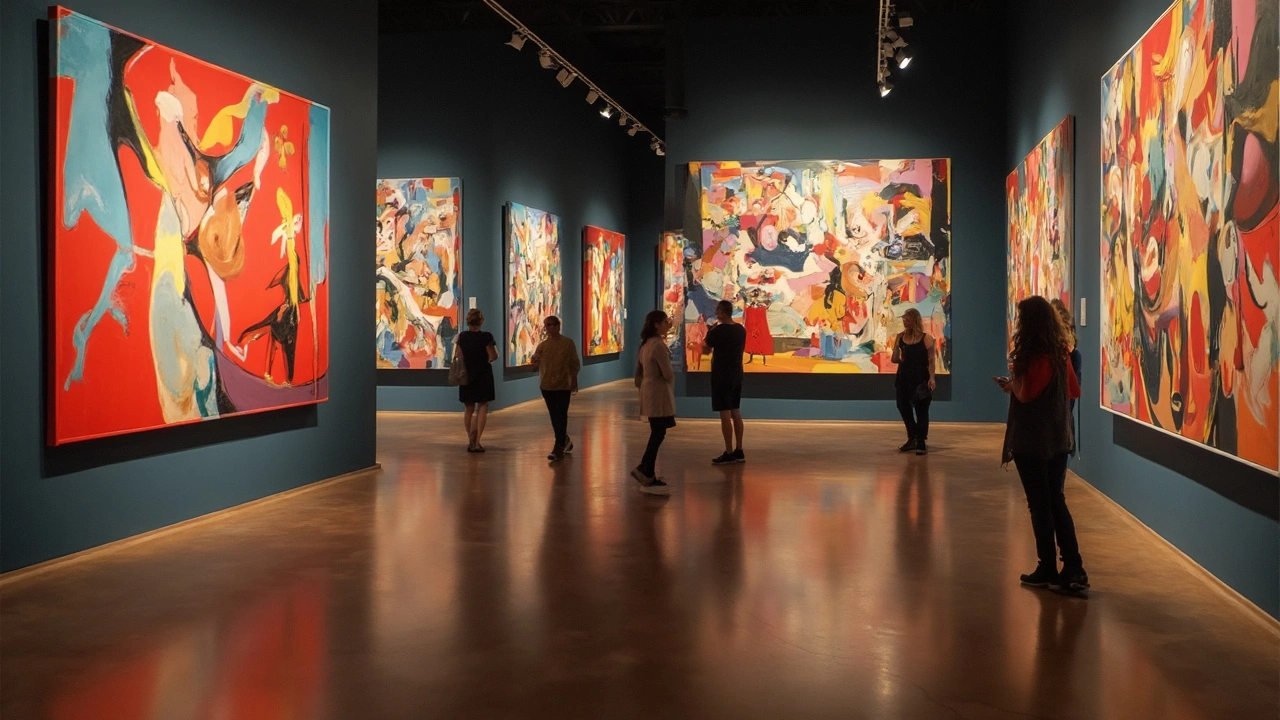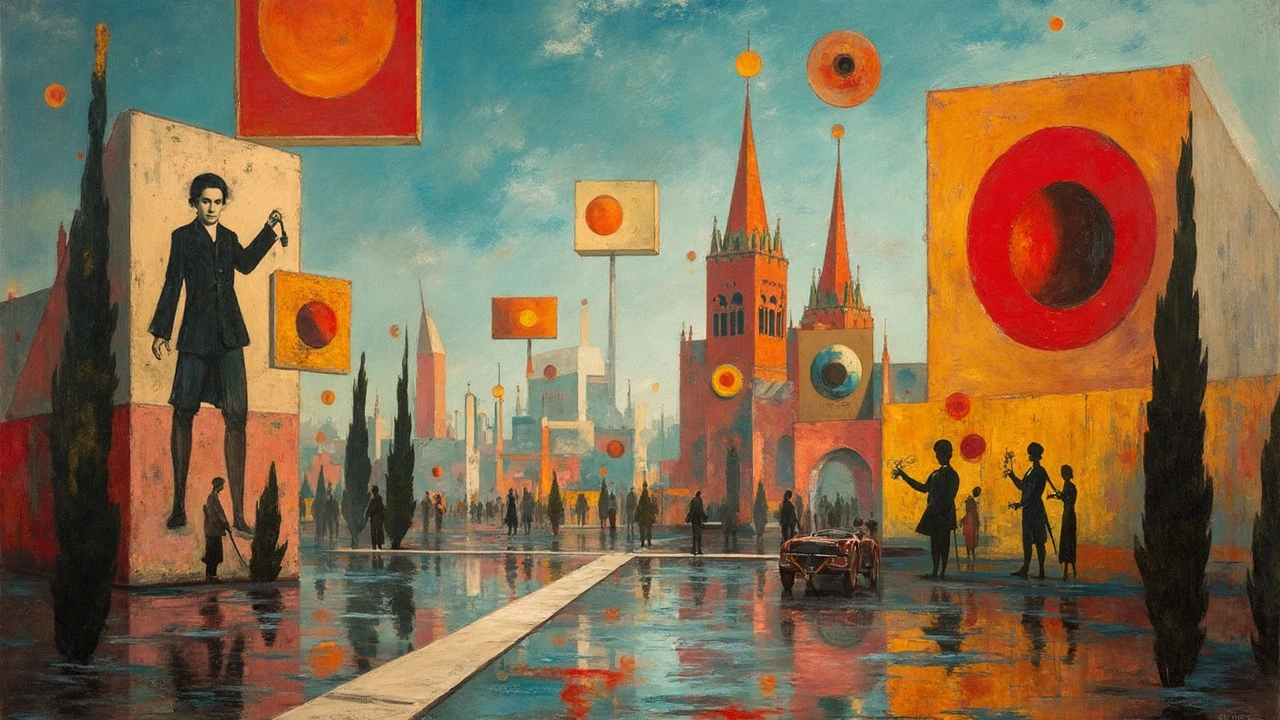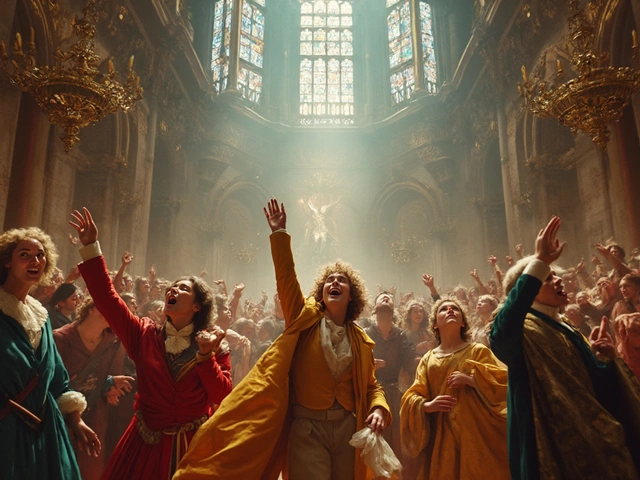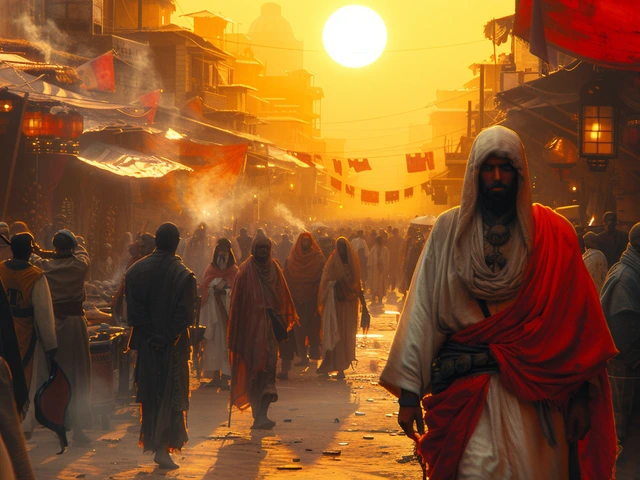Suprematism, ever heard of it? It's not just another fancy art term. It's a radical movement that flipped the art world upside down back in the early 1900s. Picture this: out of the blue, artists ditching the obsession with depicting objects and diving deep into basic geometric forms—like squares, circles, and lines. Sounds wild, right? Well, that’s precisely what Suprematism did.
Born in Russia, Suprematism was spearheaded by the bold Kazimir Malevich. Imagine slapping a simple black square onto a white canvas and calling it revolutionary. Yup, he did that. Malevich believed that art should be free from the clutter of reality, focusing purely on basic shapes and colors to stir emotions. His work laid down the base for several art movements that followed.
Now, you might ask, why bother with all this geometry in art? Well, the Suprematists thought their approach offered a fresh start, leaving behind the outdated ways of representing the world around us. It was about capturing the essence of feeling through pure abstraction.
- Origins of Suprematism
- Kazimir Malevich and the Black Square
- The Supremus Group
- Impact on Modern Art
- Key Artworks and Their Influence
- Suprematism Today
Origins of Suprematism
So where did Suprematism even come from? Let's take a quick trip back to early 20th-century Russia. Things were turbulent, politically speaking. The Russian Empire was crumbling, and there was a fertile ground for radical new ideas—art was no exception.
Enter Kazimir Malevich, a guy who wasn't afraid to shake things up. He got the ball rolling in 1913 when he started experimenting with abstract ideas. Malevich wasn't just some guy with a paintbrush. He was hellbent on moving away from the traditional art of portraying objects and figures and into the realm of geometric abstraction.
Malevich's Vision
By 1915, Malevich was ready to unveil his ground-breaking vision. He introduced Suprematism at The Last Futurist Exhibition of Paintings in Petrograd (now Saint Petersburg). People were either mind-blown or scratching their heads—there didn't seem to be an in-between. He boldly claimed that his art was about the 'supremacy of pure artistic feeling.' In other words, they were exercises in freedom—free from the chains of the visual world.
Early Works
The works on display were almost other-worldly. Imagine bold shapes like cubes and squares suspended on a stark white background. Color choices were deliberate and minimal, emphasizing form over detail. To this day, his works like the iconic 'Black Square' continue to be talked about for their sheer audacity. These early pieces set the stage for future discussions in abstract art.
| Year | Event |
|---|---|
| 1913 | Malevich begins experimenting with abstract ideas |
| 1915 | The Last Futurist Exhibition introduces Suprematism |
Suprematism didn’t just pop out of nowhere. It was a reaction—a bold and revolutionary one—to the traditional art forms that dominated before. This idea of stripping art down to its raw basics was nothing short of revolutionary, and it sure did turn some heads.
Kazimir Malevich and the Black Square
Ah, the legendary Kazimir Malevich—a name that's practically synonymous with Suprematism. If you've ever seen a simple black square painted on a white canvas and wondered why it's considered such a big deal, Malevich is why. He painted his iconic Black Square in 1915, and it wasn’t some random act of minimalism. It was revolutionary and deliberate.
Malevich wanted to break free from the traditional shackles of art that demanded representation and narrative. The Black Square was more than just an art piece; it was a statement. He described it as 'the embryo of all possibilities,' suggesting a clean slate for art, free from the clutter of the material world. Talk about bold!
Unveiling the Black Square
When Malevich first exhibited this piece, it was at The Last Futurist Exhibition of Paintings in Petrograd (now St. Petersburg). The artwork was hung high in the corner, reminiscent of an icon, challenging religious and artistic traditions at once. Imagine the reactions back then! It was either seen as a stroke of genius or complete madness. No middle ground.
Legacy and Ripple Effect
The influence of Malevich's daring approach didn’t just stop at the borders of Russia. The idea that art could be liberated from the need to represent objects seeped into other movements and philosophies, like De Stijl and Bauhaus. It even echoed in modern art you see today. His work prepped the stage for purely abstract and conceptual pieces.
The Black Square isn't just a painting; it’s a doorway to a new understanding of art. It tells artists, 'Hey, it's okay to explore, innovate, and break the rules.' And that's a pretty powerful message.
The Supremus Group
So, let's dig into the Supremus Group. This was no ordinary art collective—it was more like a think tank for Suprematism. Led by none other than Kazimir Malevich, this group gathered a bunch of artists who were all about pushing boundaries and exploring abstract art in its purest form. They didn't just meet for tea; they were on a mission to redefine what art meant in the context of modern society.
The Supremus Group started around 1915, not long after Malevich unveiled his now-iconic Black Square. While Paris had its Cubists, Russia had these Suprematists, actively turning Moscow into a vibrant hub of avant-garde art. The group aimed to create an art form that existed for art's sake, moving away from traditional aesthetics and aiming for spiritual purity.
Key Figures
Now, let’s talk about some key players. Aside from Malevich, there were artists like Olga Rozanova, Ivan Klyun, and Liubov Popova. Each brought their spin to abstract art, contributing to the diverse perspective within Supremus.
Olga Rozanova was particularly notable for her unique use of color. She didn't just follow the rules; she broke them, blending hues in ways that added depth and emotion. Her abstract works like 'Green Stripe' continue to influence art today.
Activities and Influence
The Supremus Group wasn't just about creating; they were about preaching the Suprematist gospel. They planned a magazine called 'Supremus', which aimed to communicate their revolutionary ideas. Sadly, due to the turbulence of World War I, only the first issue made it to print. However, the influence of the proposed writings sparked plenty of dialogues in the art world.
Their impact extended beyond art galleries, as they believed art could transform everyday life. This notion later seeped into modern art movements that emphasized functional art, like Bauhaus. The group's ideas may have seemed radical back then, but they planted seeds that would grow over decades.
All in all, the Supremus Group was more than just a collection of artists. They were rebels with a cause, advocating that art should evolve, sometimes by distilling it down to the simplest and most profound elements.

Impact on Modern Art
So, how did Suprematism shape modern art, you wonder? Well, it's a huge deal! This movement was kind of a game-changer. Imagine the next-gen artists looking for fresh ways to express themselves without the constraints of reality—Suprematism was like their bible.
Kazimir Malevich, with his bold ideas, opened up new avenues for abstract art. The simplicity he preached in art wasn't just a phase; it stuck around and grew branches. His approach inspired movements like Abstract Expressionism and Minimalism, which you've probably heard of. These aren't just buzzwords—they're styles that defined entire eras of art.
How Suprematism Changed Perspectives
The key takeaway from Suprematism was a shift in perspective. Instead of focusing on what things look like, artists began to think about what emotions or ideas they evoke. This took the chains off creative expression, allowing artists to explore more radical themes and techniques.
- Expression over Representation: Going beyond just what things appear to be.
- Freedom in Forms: Encouraging use of basic shapes and simplicity.
- Color as Emotion: Using strong colors to convey feelings rather than depict reality.
Its Reach Beyond Paintings
But it wasn't just about paintings. The Suprematist philosophy bled into architecture, design, and even fashion. You see a sleek, modern building with clean lines and you might just be looking at a distant cousin of Suprematist principles.
Even today, graphic designers and digital artists often draw from Suprematist ideas, proving that this early 20th-century movement still has legs. Its long-lasting impact is a testament to how groundbreaking Malevich's ideas truly were.
So, next time you see a minimalist design or a fancy geometric pattern on a magazine cover, remember—it's not just there to look pretty. There's a good chance it's echoing the influence of the fearless Suprematists.
Key Artworks and Their Influence
Suprematism isn't just about throwing some shapes together. It packs a punch with some heavyweight works that left a lasting mark. The hallmark of this movement undoubtedly kicks off with Kazimir Malevich's Black Square. Unveiled in 1915, it sent shockwaves through the art scene. Why? Because it dared to be simple – no frills, just raw expression. This piece became an icon for Suprematism and abstract art in general, shaping how we think about modern art.
But that's not all. Malevich didn't stop at one square. His White on White further pushed the boundaries. Imagine a white square slightly tilted over a white background. Bold move, right? It challenged viewers to appreciate nuance and contemplate infinity in simplicity.
Other Notable Artworks
Malevich wasn't the only player in town. Fellow Suprematists brought their flair to the table:
- El Lissitzky's Proun series: These works were less about static art and more about bridging architecture and painting. Kind of like early 3D renderings, these pieces taught artists to view dimensions differently.
- Olga Rozanova's Painterly Architectonics: Rozanova wasn’t afraid to play with color and form. Her vibrant arrangements offered a poetic twist to Suprematism, proving the movement's versatility.
Influence on Modern Art
Suprematism laid down the groundwork for future art movements. Its principles echoed in the Bauhaus, De Stijl, and even modern minimalism. It inspired architects and designers to embrace simplicity and purity of form. To this day, those basic shapes and colors continue to fuel creative expression across various mediums, securing Suprematism’s place in the art world's Hall of Fame.
Suprematism Today
So, where does Suprematism stand today? Although we're a century removed from its inception, its influence is still kicking around, reshaping how we think about abstract art. Designers, architects, and artists across the globe continue to draw inspiration from these early geometric experiments.
Let’s chat about the digital era. With technology blurring more lines between art forms, Suprematism's emphasis on simplicity and pure forms has swooped into the digital art scene. You’ll find it in everything from minimalist web design to cutting-edge virtual reality art exhibitions. It's all about making that emotional connection without overwhelming the senses.
The Minimalist Wave
Suprematism's stripped-back aesthetic resonates with today's minimalist trend. Ever noticed how streamlined most smartphone interfaces look? Or those cool, uncluttered spaces in modern architecture? Many of these designs cut their teeth on the concepts championed by Suprematism. It's about more than just aesthetics; it's about communicating an idea as clearly and effectively as possible.
Educational Influence
The movement has found its way into many art education curriculums. Schools teach students to appreciate how avant-garde ideas like those in Suprematism challenge conventional thinking. It urges budding artists to push boundaries and redefine what’s possible in their work.
Besides that, Suprematism has also inspired reinterpretations in sculpture and installations. Artists use 3D printing to create stunning geometric sculptures, perfectly echoing Malevich’s vision in contemporary forms.
- Virtual reality making Suprematist ideals interactive.
- Minimal app interfaces owe much to its principles.
- Architectural designs emphasize form purity.
In summary, while the days of Malevich may be behind us, Suprematism's spirit lives on, manifesting in ways he might’ve never imagined but probably would have totally supported.




